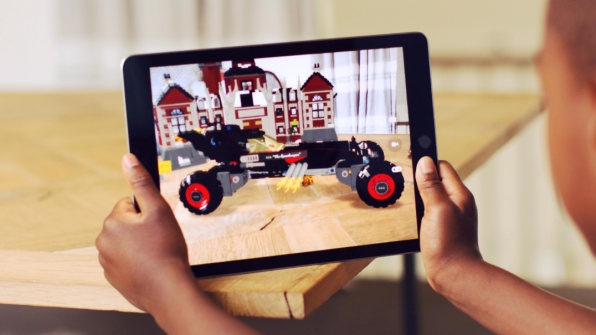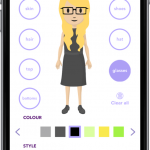Obvious: AR Made With Apple’s ARKit Would Work Way Better On iGlasses
Shortly after Apple’s Worldwide Developer Conference earlier this month, I wrote that the announcement of Apple’s new augmented reality developer tool ARKit would lead to new 3D sensors in future iPhones. That’s true, but it seems inevitable that it’ll lead to something more interesting–a set of AR glasses–a little later on.
Apple has very likely been prototyping such a device for some time now. Its strategy is the opposite of that used by Google to introduce its ill-fated Glass glasses (dumb name too, come to think of it). Apple is getting developers working on creating the AR experiences before eventually announcing its iGlasses, or whatever it’ll call them.
Here’s IDC analyst Tom Mainelli writing for Techpinions shortly after WWDC:
“I fully expect to hear Tim Cook announce during [Apple’s fall event] the number of AR-enabled apps already available in the iOS App Store,” Mainelli wrote. “And the success of developers in creating AR apps for the iPhone and iPad will naturally lead to what logically comes next: a head-worn AR product from Apple.”
He’s spot on. While I watched Apple giving developers a taste of some of the AR experiences they might create with ARKit, it was clear to me that most of them would work way better on a head-worn device, preferably a device in the vein of the sunglasses or reading glasses we’re already used to.
Heads-up, Not Phone-up
There are various, fairly obvious, reasons that the glasses will be preferable to the current mode of experiencing ARKit creations–through the screen of the iPhone. Excluding owners of the iPhone 7 Plus (which has two camera lenses), most of the iPhones that will play ARKit apps are single-camera phones. The field of view of a single iPhone camera is limited, as is the display width of a phone held in front of one’s face is limited.
The AR scene in an ARKit experience moves with the view of the camera and the angle of the phone, but that movement depends on movement of the user’s arm and hand (or entire body, through feet-shuffling). This feels a little awkward because we are used to shifting our field of view by moving our eyes and our head. The first AR glasses probably won’t respond to our eye movements, but they will allow us to shift our field of view via head movement.
And, of course, AR glasses would leave both hands free. This is a big deal, because many of the best AR experiences will be ones that guide us while our hands are busy doing other things. You can imagine seeing driving directions or place markers in the glasses while both hands are on the steering wheel.
Some AR apps we’ve already seen use graphics superimposed on the real world to guide our hands. Imagine wearing AR glasses superimposing assembly instructions over the new Ikea table and chairs you just bought. Try doing that with a phone held up to your face.
Playing The Long Game
Apple has been thinking about AR and VR for years. Tim Cook told The Washington Post last year that “AR is an extremely interesting and sort of a core technology.” He’s also said AR should be a “heads up” experience. This suggests Apple was and is thinking very seriously about an AR headset or glasses, with AR on phones an interim step.
At the same time, Apple is very thoughtful–and even skeptical–when it comes to shiny new technologies like AR. It’s inclined to hang back and wait for evidence that consumers really care. Apple’s introduction of ARKit should be read as a definite commitment to AR, but it can also be seen as a way to collect more information–to see how truly serious and excited the developer community is about the technology.
Developers, after all, must make real-world decisions about whether to dedicate precious resources to developing on this platform or another one. The extent to which they embrace ARKit will say a lot about real demand for consumer AR. If developers can define or create markets for their AR apps, we’ll almost certainly see Apple give consumers something better than a phone with which to consume AR content.
Apple did some important things to sweeten the proposition of developing on ARKit. It offered a huge, immediately addressable market; anybody with an iPhone ( with an A9 chip or higher) can run the ARKit apps the developers create. And developers don’t even have to start from scratch–they can use ARKit to imbue existing apps with AR magic.
“Later, when the company has figured out the right user interface and form factor to produce a pair of Jonathan Ive-approved glasses, it will already have a sizable installed base of AR apps ready to go,” Mainelli wrote in an email to Fast Company Thursday. “As is often the case, Apple is playing the long game here.”

Wait For It
How long that game really is will depend in part on advances in chips and optical tech.
“The technology needed to create the type of glasses that would work really well and also be fashionable is just not here yet,” says Creative Strategies president (and long-time Apple analyst) Tim Bajarin.
“I have looked at all that are out already and a few in the works and none of them deliver on the type of design and function that anyone would want to use a lot as the go about their daily business,” he adds.
And that’s the big difference between the AR we’ve seen to date and the AR that’s coming. Today AR is being used for highly specialized tasks, then put aside when the task is done. Tomorrow’s AR will be far less episodic.
“Instances of AR on phones and tablets are incredible, but they only deliver augmented experiences,” says Brent Marcus, VP of Strategy at the science fiction prototyping firm SciFutures. “AR glasses could deliver an augmented existence.”
Bajarin believes we are still two to three years away from seeing a pair of consumer AR glasses good enough to have mainstream potential.
By releasing ARKit when it did, Apple, has started the time clock for the tech-buying public to get warmed up the AR concept. Right now Pokémon Go is the closest most people have ever come to understanding and appreciating it. A new wave of impressive ARKit apps, games, and other experiences might convince everyone that there’s more to AR than Pokémon. A less compelling first wave of apps might keep wide acceptance of AR moving at a crawling pace. Apple’s challenge is to be ready with a killer pair of AR glasses when the public is ready–not before, and not after.
ARKit may be just the first step in a warmup process that leads to the release of Apple AR glasses.
Shortly after Apple’s Worldwide Developer Conference earlier this month, I wrote that the announcement of Apple’s new augmented reality developer tool ARKit would lead to new 3D sensors in future iPhones. That’s true, but it seems inevitable that it’ll lead to something more interesting–a set of AR glasses–a little later on.
Fast Company , Read Full Story
(57)













